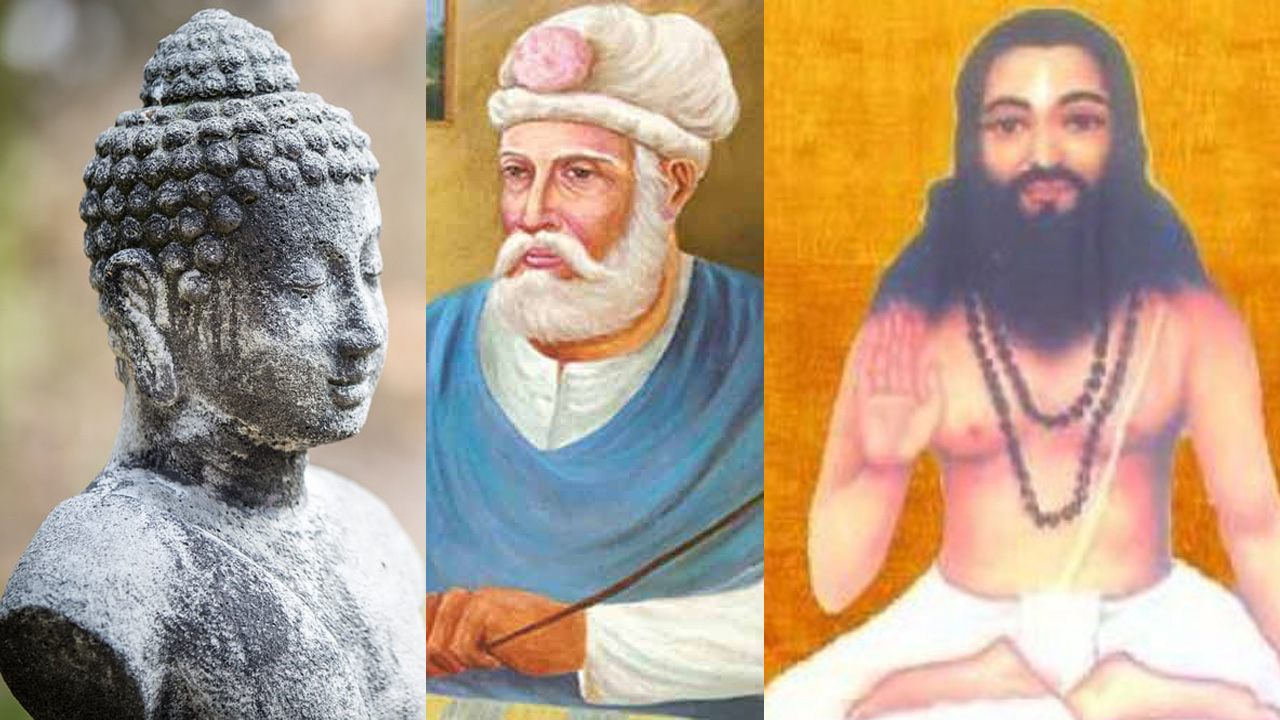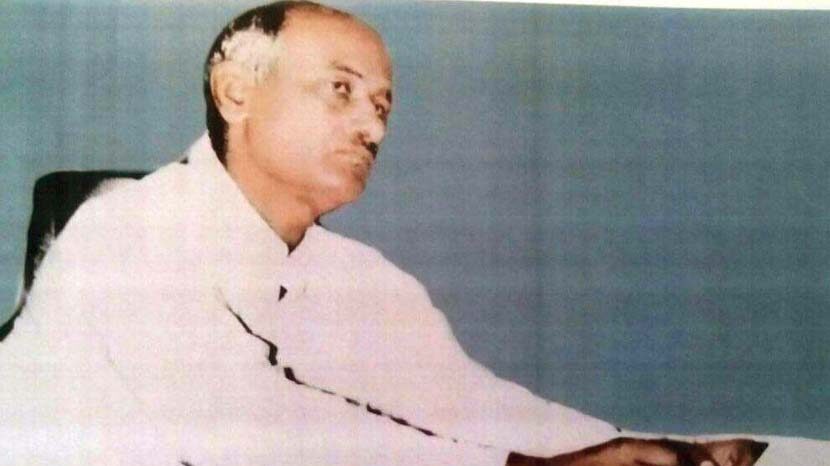While the caste system is the noose around the Bahujans, it is the shield to protect the privileges of a handful of people. The Brahmins and the savarnas want to perpetuate the caste system. They want the Shudras and the Dalits to remain where they are. They have been conspiring to achieve this objective at both social and psychological levels. Their efforts are geared towards keeping the hearts and minds of the Bahujans under their control. The Brahmin want the Dalits and the Shudras to accept the status quo – to believe that their sufferings are their destiny. To this end, they not only tampered with the culture of the non-Brahmins but also deprived the latter of their heroes and their history. Take, for instance, what Bhaktamal says:
“Ramanand ji had a Brahmachari disciple. Every day, he brought home wheat flour after begging in the village. It was offered to the Lord and was also used to feed the saints. A Bania lived nearby. Many a time, he requested the Brahmachari to accept ‘seedha’ [uncooked food] from him. However, the Brahmachari refused in keeping with Swami ji’s instructions. One day, it was raining heavily. But food had to be arranged. The Brahmachari, ignoring the command of his guru, brought ‘seedha’ received from the Bania. Once the seedha was cooked, the guru offered it to the Lord and meditated. But the image of the Lord would not appear before his eyes. So, he asked his disciple, ‘From where did you get alms today?’”
“The disciple told him what happened. Then, the guru narrated the story about the Bania. He said that the Bania was a man of degraded mentality who, blinded by his lust for money, did business with a Chamar. The guru was very angry and cursed his disciple saying, ‘You have disobeyed the command of your guru. Hence, you will be born into a lowly family.’ That disciple was reborn into a Chamar family as Raidas.”[1]
Before we discuss the implications and the hidden meanings of this myth, let us see what happened next:
“Infant Raidas did not even like his mother’s touch, let alone drink her milk. As he had served his guru well, he remembered everything about his previous birth. He thought that if he had to undergo this predicament merely for begging at a Chamar’s place what would happen if I drank my mother’s milk! In the meantime, an akashwani (message from the god) reached Swami Ramanand ji that his disciple had been reborn into a Chamar family and that he should help him. He was pained to hear this and immediately went to the place where Raidas was born. The parents were worried as Raidas was not drinking milk. As soon as they saw Swami Ramanand, they fell at his feet and pleaded with him to do something so that the child started drinking his mother’s milk. Then, Ramanand ji gave the child ‘diksha’ in the name of Ram (Rum ramayah namah) and made him his disciple. That washed off all his sins and he started drinking his mother’s milk. It was sort of a rebirth for Raidas and he started treating Swami Ramanand as his god. He was freed from the agony that was tormenting him due to the blunder he had committed in his last birth.”[2]
Further, it says that as Raidas grew up, he increasingly immersed himself in devotion to god. He worshipped the sadhus and saints who came to his home and played a genial host to them. Beggars had the first claim over whatever he earned through his toil. Only what remained was his. He had no interest in the worldly possessions. Ultimately, in the words of Nabhadas:
“With the blessings of god, Shri Raidas ji obtained the supreme position, akin to assuming the king’s throne, in his mortal self. By showing the marks of the Yagyopaveet (sacred thread) on his body he convinced the people that he was a Brahmin in his previous birth.”[3]
Those who hold Bhaktmal in reverence can well be asked how a Brahmin like Ramananda could have visited a home where animal skin was tanned, in a locality where the Atishudras and the Chandals lived. It would also be fair to ask how an infant could have imbibed the meaning of the Ram Mantra. Also, how it was that the child could live in the womb of her low-caste mother for months but refused to be breastfed immediately after birth! Then, if uttering the name of Ram could make one a great scholar, why did all the 52 disciples of Ramananda not attain the same eminence as Raidas? But the problem is that devotion hinges on faith. The devotee is not supposed to ask questions. Since man is characterized by the power to reason, we can safely conclude that the Bhakti Marg, which some call Bhakt-Vedanta, is a brahmanical stratagem to entrap society and is an obstacle to rational and logical thinking.

Nowhere does Raidas say that Ramananda was his Guru. Not only did Raidas flay the Varna system and the religious rituals, the inventions of the Brahmins, but he also rejected the Vedas, which, as an Atishudra, he was not allowed to read – merely hearing them being recited made him liable to severe punishment.
Chariu Vedi kiya khandoti
Tako vipra kare dandoti
—–
Jag mein Ved vaidya janye
Padhat samaj kuch n aawat
Like Raidas, Kabir, too, was not spared. Shyamsundar Das relates the story of his birth in the following words:
“In Kashi, there lived a righteous Brahmin. He was a great devotee of Swami Ramananda. Once he went to Ramanand’s ashram along with his widowed daughter. When the daughter respectfully greeted Ramananda, he blessed her saying that she would become the mother of many sons. The Brahmin was taken aback and told Ramanand that his daughter was a widow. Ramanand replied, saying that his blessings would bear fruit and that the Brahmin should take consolation in the fact that the woman’s son would be a man of great fame. A son was born to the Brahmin’s daughter. For fear of social opprobrium and shame, the Brahmin left the baby by a water tank.[4] The child was brought up by a weaver called Neeru and he grew up into, in the words of Shyamsundar Das, ‘Kabir, an ardent devotee of god’.”
To ensure that not an iota of doubt remained as to Kabir being a Bhaktimargi like Surdas and Tulsidas, another story was coined. It is said that Kabir was a disciple of Ramananda. It is another matter that like Raidas, Kabir also stoutly decried the rituals and the hypocrisies of the Brahmins and the priests. He launched an acerbic attack on the Brahmins, who swore by the Vedas, and all their creations. “They read the Vedas and indulge in self-praise yet the shadow of suspicion does not leave their minds.”
Padhein Ved aur karein badhayee
Sanshay ganthi ajahoon nahin jayee
Kabir’s poetry represents a quest for the truths of life. Before embarking on that quest, it is essential to reject pomp and show. False pride in one’s religion or caste will not work here:
Kabira ka ghar sikhar pai jahan silhali gail
Paon na tike pipilika pandit bandhe bail
Meaning, Kabir is seated at the summit of knowledge, the path to which is slippery. Ants (small people devoid of intellect) cannot reach there. But the Brahmins want to conquer it on the basis of their false intellectual pride and hypocrisy.
Does the brahmanization of geniuses like Raidas and Kabir symbolize the magnanimity of the Brahmins? Does it prove that the Varna system was flexible? Should the Bahujans be happy that at least some of the great personalities and scholars from among the Shudras and the Atishudras are attaining the status of Brahmins or even god? Should they be thankful that some of them could rise above the humiliating status ordained for them by the caste system? If the answers to these questions are in the affirmative, it will be a resounding victory for Brahmanism, for this will mean acceptance of the caste system, which is against natural and social justice both. Bahujans won’t realize that Brahmanization (or deification) of a great personality is tantamount to rejecting the possibilities of transformation initiated by him. Brahmanization takes the sheen off that great personality. A brahmanized Kabir seems to be supporting what he, in fact, was dead opposed to. This is how an emerging movement is nipped in the bud.
Usurping influential non-Brahmin personalities by brahmanizing them is an old, time-tested stratagem. More than 2,000 years ago, the Brahmins had declared Gautam Buddha to be an incarnation of Lord Vishnu. The same proclivity was at work when it was declared that Valmiki was the son of a Brahmin. They weave some miraculous tale about the life of that person or about his earlier births. That tale is publicized through literature – written or oral. If needed, they insert the concocted tale in Puranas or other scriptures to make it a part of the brahmanical canon. Of course, they take full liberty with the facts, twisting the revolutionary thoughts of the person concerned in such a way that they appear to be patronizing to and supportive of Brahmanism. Quoting popular legends/scriptures they convince the people that the great man’s intellect and contribution were not the outcome of his brilliant mind, hard work and dedication but of divine blessings. This ensures that instead of trying to read, understand and draw inspiration from the thinking of that personality, his followers begin deifying him. They feel grateful to the Brahmins for honouring a non-Brahmin personality. They also start believing that the new generation of the Brahmins is not as rigid as their forefathers were. Their anger and resentment against the Brahmins and the brahmanical social order gets diluted. In short, the brahmanization of great personalities, howsoever phony it may sound, leads to brahmanization of society and gradually weakens the momentum of transformation initiated by those personalities.
Also read: Raidas Saheb and the idea of Begumpura
No society can change unless it wants to. The desire for change is a function of the anger against the status quo. Lofty, positive and realistic inspirations spur change. In the words of Brazilian educationist Paulo Freire, “In order for the oppressed to be able to wage the struggle for their liberation, they must perceive the reality of oppression not as a closed world from which there is no exit, but as a limiting situation which they can transform.”[5]
The emancipation of the Bahujans requires such a vision and an endeavour to dig out the truth about the scriptures, cultural traditions and customs. What is needed is a deconstruction of the established notion and an innovative reconstruction to bring out the real, people-oriented truth. Here, an episode described in the Chandogya Upanishad would be in order:
“Eager to attain knowledge, Satyakama went to the ashram of the great sage Haridrumata Gautama. Before accepting him as his disciple, the teacher asked him about his Kula and Gotra. Satyakama went back home and relayed the question to his mother. Her mother replied that he was of uncertain parentage as she used to go from home to home to grind grain and couldn’t say who fathered him. The boy passed on these details to the sage, adding that his mother was Jabali and he was Satyakama Jabali. Impressed with the answer, the sage declared, “Who can such a truthful child be but a Brahmin? Go get sacrificial firewood. I will give you diksha.”
This story is often cited as proof of the liberalism and broadmindedness intrinsic to the Varna system. Those who read and hear these stories are filled with joy. Many intellectuals, including Dr Sarvapalli Radhakrishnan, have alluded to the story in their studies of ancient Indian culture and philosophy. Under their influence, it is accepted that at least initially the concept of the Varna system was flawless and liberal. The Bahujan mind, which has accepted for centuries falsehoods peddled by the Brahmins as truth, is unable to see through the real brahmanical implications. When Gautama declares that Satyakama is a Brahmin just because he doesn’t hesitate to reveal even an inconvenient truth, does he not brand everyone else as liars? Moreover, he downplays the sexual exploitation of the poor, helpless women who went from home to home to grind grains, which actually reveals the plight of women in that society. The scriptures are overflowing with such stories. They need to be re-interpreted from the Bahujan perspective. Phule had begun that process and Ambedkar and Periyar took it forward.
History is not the handmaiden of those who wield the sword. It is the product of those who hold the pen. Even if those who hold the pen are forced to falsify history by those wielding the sword, the result won’t last, for the moment the threat of the sword diminishes, those holding the pen start rewriting a truthful account of the past. Hence, to free themselves from the stranglehold of the selfish and unwelcome brahmanical intervention, the Bahujan scholars need to come forward and sharpen their intellect. Understanding the conspiracy behind the symbols and myths foisted on society by the Brahmins under the garb of religion and culture, they need to reinterpret these myths and symbols in the light of justice, liberty and equality. That is the only way to reclaim and protect the dignity and the respect of Bahujans.
[1] Ramananduju kau shishya brahmachari rah eek gahe vritti chutki kee kahe tanson baniyon
Karo angikaar seedho das-bees baar barse prabal dhar tamein vape aaniyon
Bhog kon lagawe prabhu dhyan nahin aave are kaise kare lyavey jay poochi neech maniyon
Diyo shaap bhari baat suni na hamari ghati kul mein utaree dehee shoyeen yako janiyon
(Shribhaktamaal, Nabhadas, Bhakti-Ras-Bodhini-Teeka; Vyakhyakar: Shriramkrishnadev Garg, Shri Akhil Bharatiya Shrinimbaryacharya Peeth, Vrindavandham, 1960)
[2] Maata doodh pyavey yankon chuyou nab have sudhi aave sab pachili suseva kon prtap hai
Bhai nabh-bani ramanand man janee bado dand diyo manee vegi aayo chalyo aap hai
Dukhi pitu-maat dekhi dhaay laptaye pay kijiye upay kiye shishya gayo paa hai
Stan paan kisee jiyo jilyo unhein ees jati nipat agyani pheri bhule bhayo taap hai (ibid)
[3] Bhagwat kripa Prasad param gati ihee tan payee. Rajsimhasan Baithi Gyati Parteeti Dikhayee (ibid)
[4] Introduction to Kabir Granthavali, edited by Shyamsundar Das, Hindi Samay
[5] Paulo Freire, Pedagogy of the Oppressed, translation: Rameshchandra Shah, Granthshilpi, New Delhi.
(Translation: Amrish Herdenia; copy-editing: Anil)
Forward Press also publishes books on Bahujan issues. Forward Press Books sheds light on the widespread problems as well as the finer aspects of Bahujan (Dalit, OBC, Adivasi, Nomadic, Pasmanda) society, culture, literature and politics. Contact us for a list of FP Books’ titles and to order. Mobile: +917827427311, Email: info@forwardmagazine.in)
The titles from Forward Press Books are also available on Kindle and these e-books cost less than their print versions. Browse and buy:
The Case for Bahujan Literature
Dalit Panthers: An Authoritative History







